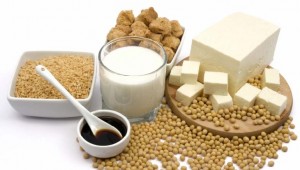 This April, National Soy Foods Month, organized by the Soyfoods Association of North America, takes place for the fifth year running. Being the most consumed, used and grown legume in the world, soy appears to be one of the most popular health products that people enjoy in different cuisines across the world. This month, why not learn more about the versatility of this product.
This April, National Soy Foods Month, organized by the Soyfoods Association of North America, takes place for the fifth year running. Being the most consumed, used and grown legume in the world, soy appears to be one of the most popular health products that people enjoy in different cuisines across the world. This month, why not learn more about the versatility of this product.
This year there is an emphasis on the importance of creating swapportunities in your diet (i.e. opportunities to swap unhealthy foods for healthier options). It also encourages people to add soy foods to their diet on a regular basis. Soy foods are, not only nutritious and healthy, but are also affordable and can be easily added to everyday family meals; the flavour blends and replaces other ingredients well in many dishes. By combining soy alternatives with some of your own creativity, it is surprising how easy it is for families to incorporate the (complete) plant-based protein into their favourite meals.
According to Stacey Kwawczyk, a Research Dietitian for the National Soybean Research Laboratory, “soy foods are a nutritious option for children and busy families” and contain “all essential amino acids just like animal protein.” However, in contrast to many other protein sources, “soy foods are cholesterol-free and low in saturated fat.”
Feel super with soy foods
Did you know soy is one of the most researched foods on earth, especially in the last few decades:
- Soy helps control blood sugar and can lower your cholesterol, which is important in lowering your risk of heart disease.
- Women who eat soy products (or have eaten them throughout their life), often experience less hot flushes during their menopause.
- Soy fiber helps you to manage your weight, as it increases your satiety (feeling of being full) and this decreases the urge to eat and snack later on in the day.
- The nutrients of soy are essential for growth and the health development in children. Children that eat meals which contain soy, may be helping to prevent the later development of certain diseases.
- It is also thought to decrease the risk of breast cancer.
Tips and ideas on how to fit soy foods in your daily meals
There are plenty of different soy products to try, so here’s some ideas that will help you getting started adding soy to your meals:
 Make a smoothie with soy milk, which contains about 7g of protein per serving and can be made in all kind of variations. You can also use soy milk in cakes, muffins and pancakes. You can even pour it over your cereal in the morning.
Make a smoothie with soy milk, which contains about 7g of protein per serving and can be made in all kind of variations. You can also use soy milk in cakes, muffins and pancakes. You can even pour it over your cereal in the morning.- Snack on (roasted) soy nuts or use soy nut butter instead of peanut butter.
- Sprinkle edamame over your salad, a young soybean that can be eaten fresh and really punches up the protein count of your meal.
- Use soy crumbles for tacos, wraps and spaghetti.
- Experiment with tofu and tempeh; mix tofu through your guacamole or grill a slice of tempeh with a spicy sauce.
Depending on your tastes and preferences (and those of your children), you can always find a healthy soy food that can act as a replacement or an enhancer to any meal. Whether you’re a vegetarian, a vegan or just someone who likes to experiment in the kitchen, soy products are a good alternative to bring variety to your meals. As well as making your meal times more exciting, variety is also a key factor to a healthy diet.